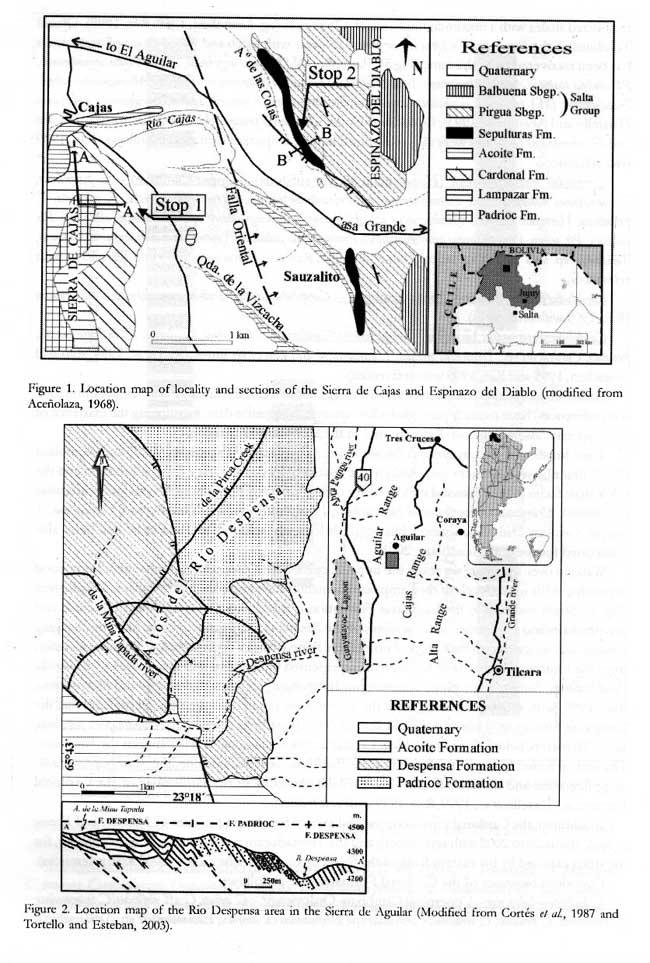
Updated stratigraphy and biostratigraphy of the Sierra de Cajas / Espinazo del Diablo (Upper Cambrian – Lower Arenig), Jujuy province, Argentina
Guillermo F. ACEÑOLAZA1
1 INSUGEO – Facultad de Ciencias Naturales e I.M.L., Universidad Nacional de Tucumán, Miguel Lillo 205, 4000 Tucumán. E-mail: insugeo@unt.edu.ar
Palabras clave: Estratigrafía. Bioestratigrafía. Cambro-Ordovícico. Cajas. Jujuy. Argentina.
Key Words: Stratigraphy. Biostratigraphy. Cambrian-Ordovician. Cajas. Jujuy. Argentina.
Introduction
The Sierra de Cajas / Espinazo del Diablo is a classical locality for the Cambro-Ordovician transition in the Cordillera Oriental of Jujuy province, NW Argentina (Fig. 1). While Cambro-Ordovician strata characterize the Sierra de Cajas, Cretaceous/Tertiary sandstones and shales westwards flanked by highly fossiliferous Arenig shales and sandstones are displayed in the Espinazo del Diablo.
The first references to the geological aspects of the area start in colonial times, with early data during the XVII century referring to the mineralization associated to the Aguilar Granite. Lead and zinc sedex deposit associated to the granite is been exploited nowadays by El Aguilar Mining Co since the 1950 ´s (e.g. Brown 1941, 1962; Spencer, 1950, Ahlfeld, 1955; Schalamuk and De Barrio, 2002).
Among some of the pioneer papers dealing with the stratigraphy and paleontology of the area, Kobayashi (1936, 1937), Harrington (1938), Harrington and Leanza (1957), Aceñolaza (1966, 1968), Méndez (1973) and Benedetto (1977) introduced the potentiality of the area. Many other papers also focused the locality during the last 20 years, fact that has provided a fairly good amount of biostratigraphic information, that allowed the usage of the Sierra de Cajas as a reference section for the Cambrian-Ordovician boundary in the Central Andean basin (eg. Suárez Riglos et al., 1982; Alonso et al., 1982; Aceñolaza and Aceñolaza, 1992; Cuerda et al., 1992; Tortello and Aceñolaza, 1993; Rao, 1994; Rao et al., 1994; Ortega and Rao, 1994; Rao and Hünicken, 1995; Aceñolaza, 1998; Rao, 1999; Tortello et al., 1999; Albanesi and Ortega, 2002).
All localities that will be visited are placed in the northern sector of the Sierra de Cajas and close surrounding areas (Fig. 1).
Stratigraphy and Biostratigraphy
The Sierra de Cajas is a faulted west dipping anticline, whose axis displays a NNE-SSO alignment. The lowest levels cropping out in the Sierra are represented by sandstones and quartzites of the Padrioc Formation (Upper Cambrian), well exposed as the highest part of the range in the anticline nucleus. No biostratigraphic relevant material has been recovered from the sandstones and quartzites of the unit. Large scale planar and cross bedded sandstones, associated to rippled surfaces and abundant HCS structures characterize the main sedimentary structures of the Padrioc Formation. A
shallow marine paleoenvironment on a tidal dominated shore, with the development of subtidal sandwave complexes are interpreted for this unit. The Padrioc Formation was originally defined by Aceñolaza (1966) in the Sierra de Aguilar as equivalent to the Chalhualmayoc Formation (upper unit of the Mesón Group). Cortes et al.(1987) describes the Cambro-Ordovician sequence in the neighboring Sierra de Aguilar as integrated by the basal sandstones of the Padrioc Formation followed transitionally upwards by the shales and sandstones of the fossiliferous Despensa Formation (with Parabolina (N.) frequens argentina and Rhabdinopora flabelliformis) (Fig. 2). Moya (1998, 2002 with references) places the Padrioc Formation above the Mesón Group, as a different unit separated by the erosive Iruya unconformity ("Sandstone 1" of Moya). In this paper the unit is understood as in the original description (sensu Aceñolaza, 1966), equivalent to the Chalhualmayoc Formation within the Mesón Group. The Iruya unconformity is a regionally represented eustatic fall that has been equiparated to the LREE of Miller (1984) (Moya, 2002 with references).
The Padrioc Formation cropping out in the Sierra de Cajas is followed by the fossiliferous black and green shales of the Lampazar Formation, widely represented in the western and northern flank of the Sierra. Sedimentary characters and trace fossil in the last unit support a wave dominated coarsening upwards sequence, of a lower offshore / upper offshore depositional setting, between the maximum and minimum wave base setting. The ichnological record is dominated by deposit feeders (Cruziana/Skolithos ichnoassociation). Outcrops of the Lampazar Formation will be revisited in the Quebrada Azul (Fig. 1).
Following the shales of the Lampazar Formation, a succession of sandstones and quartzites assigned to the Cardonal Formation crop out in the eastern flank of the range. The unit does not crop out in the western sector as a consequence of the general structure of the range. Strata are characterized by tidal cross bedded sandstones, with frequent reactivation surfaces, fewer current rippled laminated sets and rare herringbone cross-stratification. Subtidal sandbars and intertidal sandflat settings are here recognized. Surfaces dominated by Skolithos are recorded on the reactivation surfaces as colonization windows developed over the episodic influx of detritus. Scarce fossils are mentioned for these sandstones.
The Cardonal Formation is followed by grayish and yellowish shales and sandstones of the Acoite Formation (Uppermost Tremadoc-Lower Arenig), returning to a deeper and softer lower offshore type of setting. Strata of the Acoite Formation are well exposed along the cliffs of the Rio Cajas.
Finally, the early referred Cambro-Ordovician sucession of the Sierra de Cajas ends up with a highly fossiliferous small and uncomplete sequence of the more paleoenvironmentaly restricted Arenig Sepulturas Formation in the Espinazo del Diablo. The Lower Arenig strata is interrupted upwards by the Cretaceous/Tertiary red beds of the Salta Group.
The transition of the Cambro-Ordovician sequences were united in a local stage named as Cajano by Aceñolaza (1992). This includes several siliciclastic units in the NW region of Argentina.
Stop 1- Quebradas Azul and Amarilla
(Upper Cambrian and Lower Tremadocian: Padrioc, Lampazar and Cardonal formations)
The Quebrada Azul section is a small gore descending northwards from the Sierra de Cajas (Fig. 1, A-A).
The Lampazar Formation at the Quebrada Azul starts up in the middle sector of the unit. The base has not been recognized in the area (Fig. 4). Strata are characterized by highly fossiliferous

tectonized shales with a maximun thickness of 178 meters (eg. Aceñolaza, 1969; Rao, 1999). Olenid Trilobites of the Parabolina (N.) frequens argentina biozone with a rich and varied fauna of agnostoids has been recovered from the same (Fig.5): Parabolina (N.) frequens argentina, Parabolinella argentinensis, Plicatolina scalpta, Angelina hyeronimi, Beltella ulrichi, Shumardia (Conophrys) erquensis, Micragnostus vilonii, Neoagnostus (M.) tmetus, Leiagnostus turgidulus, Pseudoperonopsis zuninoi and Gymnagnostus bolivianus (Tortello and Aceñolaza, 1993). Conodonts of the Cordylodus proavus (H. hirsutus subzone), C. caboti and C. intermedius biozones were also recognized in the Lampazar Formation as follows (Rao, 1999 with references):
Cordylodus proavus biozone (Hirsutodontus hirsutus subzone) – Upper Cambrian -: C. primitivus, Eoconodontus notchpeakensis, Eoconodontus sp., Fryxellodontus sp., Furnishina furnishi, F. gladiata, F. primitiva, Hertzina elongata, Hirsitodontus aff. H. hirsutus, Iapetognathus? sp., Phakelodus elongatus, Ph. simplex, Ph. tenuis, Proconodontus prosterocostatus, Prooneotodus gallatini, P. rotundatus, Teridontus nakamurai, Teridontus sp. and gen et sp. indet. (Rao et al., 1994, Rao and Hünicken, 1995 and Rao, 1999 with references).
Cordylodus caboti biozone – Upper Cambrian - : Cordylodus caboti, Teridontus gracilis and T. nakamurai (Rao, 1999 with references).
Cordylodus intermedius biozone – Uppermost Cambrian- : C. caboti, C. durcei, C. intermedius, C. proavus, Cordylodus sp., Teridontus gracilis, T. nakamurai and gen et sp. indet. (Rao et al., 1994, Rao and Hünicken, 1995 and Rao, 1999 with references).
Ordovician brachiopods are little known fossils in the Central Andean Basin. Benedetto (2002 with references) have recently presented a first attempt to organize data, mentioning the existence of monospecific assemblages of Kvania n. sp. 1 in the Lampazar Formation.
Trace fossils were also analyzed in the sequence. Aceñolaza and Fernández (1978) and Aceñolaza (2001) describe several traces and highlight the relation between the trace fossil association and the black shale facies in the lower and middle sector of the Lampazar Formation. Several icnogenus were mentioned: Cruziana, Dimorphichnus, Isopodichnus, Planolites, Rusophycus, Skolithos and Tomaculum. A unique Cambro-Ordovician worm like fossil, informally referred to Paleoescolex has been also mentioned for the unit (Aceñolaza, 2001).
Walking over the range we reach the upper sector of the Quebrada Amarilla, with fairly good exposures of the upper levels of the Lampazar Formation and almost the entire Cardonal Formation (Fig. 1). Strata assigned to the Lampazar Formation is represented by fossiliferous greenish and grayish shales and sandstones with Trilobites of the Parabolina (N.) frequens argentina biozone changing transitionally upwards into the Cardonal Formation. Benedetto (1977) describes a trilobite association from the southern Quebrada de la Vizcacha, represented by elements of Pseudotalbotina, Aguilarella, Paraplicatolina, Buttsia, Pemphigaspis, Dasomethopus, Protopeltura?, Asaphellus, Onychopyge and Pharastomina. Rao (1999, with references) recognizes the C. lindstromi biozone in the uppermost levels of the Lampazar formation, while Ortega and Rao (1994), figure the presence of Rhabdinopora parabola, about 26 meters below C. lindstromi biozone, within the transitional levels between the two units. The early referred biozone is followed by the Cordylodus angulatus biozone, the Adelograptus tenellus graptolite zone and the Kainella meridionalis trilobite biozone in the sandstones of the Cardonal Formation (Tortello et al., 1999; Rao, 1999 with references).
In addition, the Cardonal Formation yielded several Brachiopod species of Nanothis and Kvania n. sp.2, (Benedetto 2002 with references), and the Tremadocian rostroconchiid Eopteria agustini, for the strata exposed by the eastern flank of the Sierra de Cajas (Sánchez, 2000, 2002 with references).
Conodont biozones of the Cardonal Formation are as follows:
C. lindstromi biozone – Uppermost Cambrian- Ordovician? -: C. caboti, C. aff. deflexus, C. intermedius, C. lindstromi, C. proavus, C. viruanus, Cordylodus sp., Drepanodus cf. simplex, Eoconodontus? sp., Semiacontiodus
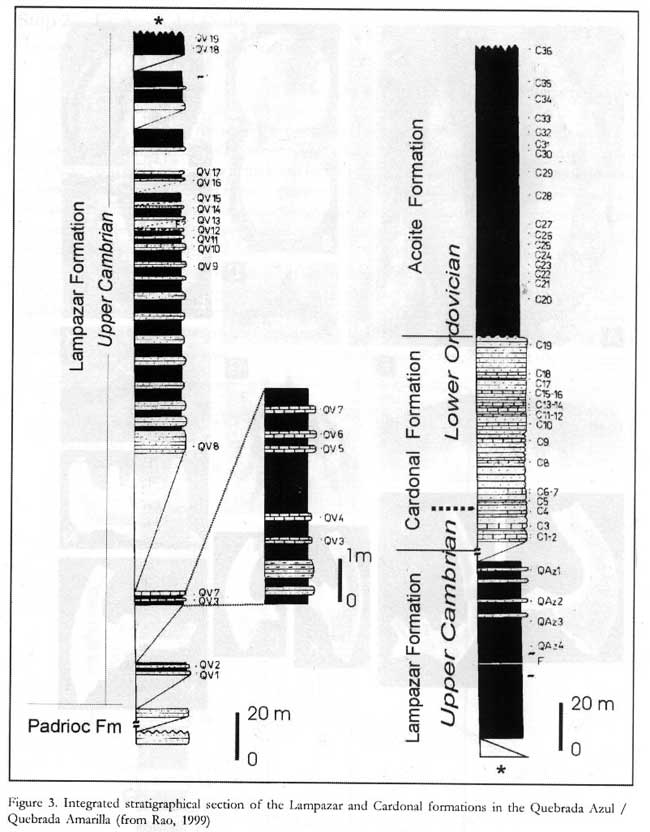
sp., Teridontus gracilis and T. nakamurai. (Rao et al., 1994, Rao and Hünicken, 1995 and Rao, 1999 with references).
C. angulatus biozone – Tremadocian-: C. caboti, C. caseyi, C. aff. deflexus, C. intermedius, C. lindstromi, C. proavus, Cordylodus sp., Drepanodus cf. simplex, Iapetognathus preaengensis, Monocostodus sp., Semiacontiodus, Teridontus gracilis and T. nakamurai. (Rao et al., 1994, Rao and Hünicken, 1995 and Rao, 1999 with references).
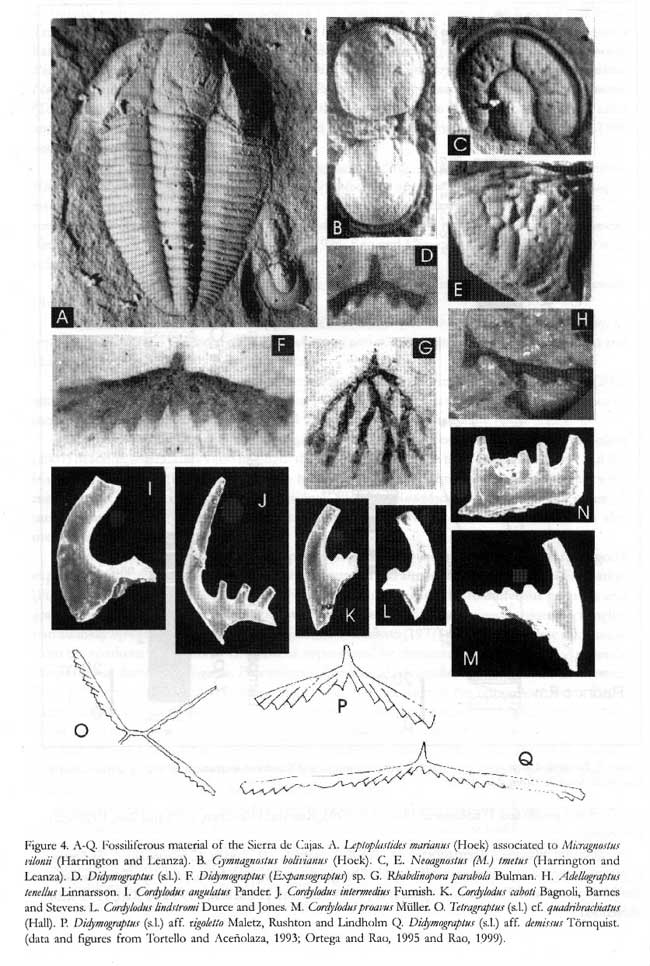
Stop 2 – Espinazo del Diablo
(Lower Arenig Sepulturas Formation)
The second and last stop in the locality will be done in the outcrops of the Sepulturas Formation by the route to Casagrande locality (Fig.1 B-B).
A fragmentary section of the Sepulturas Formation, measuring 80 meters of shales and sandstones crop out by the Arroyo de las Colas (stream) (Fig. 6). Highly fossiliferous shales and sandstones with few interbedded black limestones in the lower sector of the strata has provided a fairly good amount of fossils that helped on a better sight of the unit. Trilobites belonging to the "Hoekaspis" fauna are recorded for the locality, with abundant trinucleiids and synhomalonotiids. No graptolites were recovered yet in the section, but a conodont association of Baltoniodus crassulus andinus and Drepanoistodus pitjanti was localized in the strata (Rao, 1999 with references). An association of trace fossils related to the "Cruziana ichnofacies" has been recently described by Aceñolaza and Aceñolaza (1992): Cruziana furcifera, Cruziana isp., Monomorphichnus multilineatus, Dimorphichnus obliquus, Diplichnites isp., Monomorphichnus isp., Palaeophycus tubularis, Thalassinoides isp. and Skolithos linearis. The upper sector of the outcrop is characterized by reddish stained sandstones with a promising but little studied rich and varied fauna of nautiloids (Aceñolaza and Beresi, 2002) (Fig. 7).
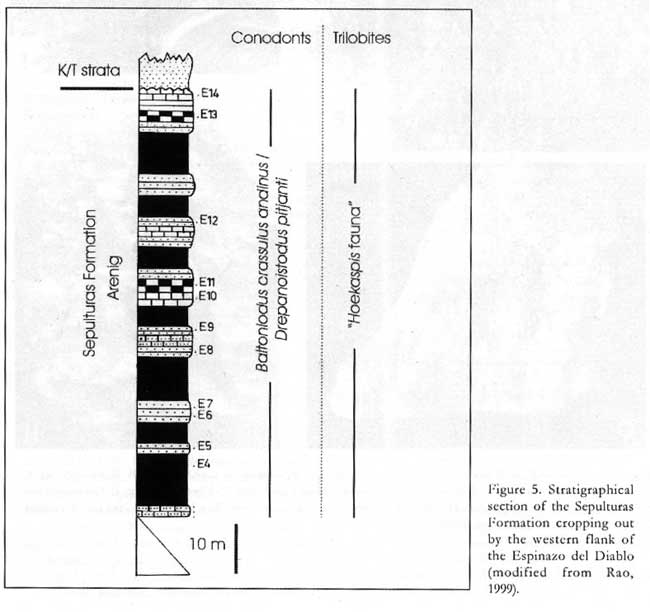
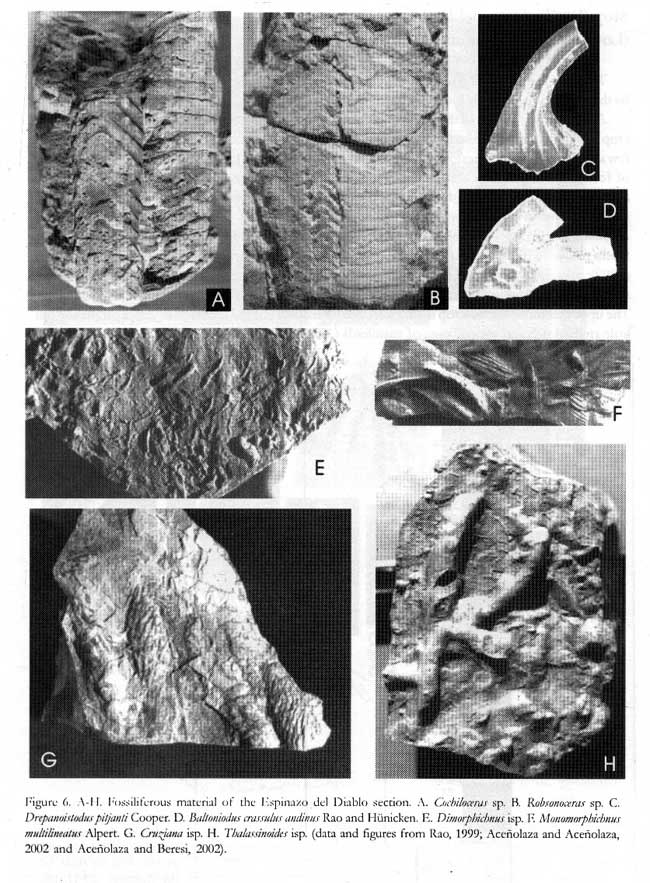
References:
Aceñolaza, F.G., 1966. Contribución al conocimiento geológico y paleontológico de la región del Espinazo del Diablo. Departamento Humahuaca, Jujuy. Tesis Doctoral Facultad de Ciencias Exactas, Físicas y Naturales, Universidad Nacional de Córdoba. Inédita: 1-159.
Aceñolaza, F.G., 1968. Geología estratigráfica de la región de la Sierra de Cajas, departamento Humahuaca, Provincia de Jujuy. Revista de la Asociación Geológica Argentina, 23 (3): 207-222.
Aceñolaza, F.G., 1992. El Sistema Ordovícico de Latinoamérica. In: J.C. Gutiérrez-Marco, et al. (Eds.). Publicación especial, Universidad de Extremadura: 85-118.
Aceñolaza, F.G. and Fernández, R.I., 1978. Trazas fósiles en el Ordovícico Inferior de la Sierra de Cajas, Jujuy. Acta Geologica Lilloana (Suplemento), 14: 33-37.
Aceñolaza, F.G. and Aceñolaza, G.F., 1992. The genus Jujuyaspis as a world reference fossil for the Cambrian-ordovician boundary. In: B.D. Webby and J.R. Laurie (Eds.), Global Perspectives on Ordovician Geology, Balkema, Rotterdam: 115-120.
Aceñolaza, F.G. and Beresi, M., 2002. Ordovician nautiloids of Argentina. In: Aceñolaza, F.G. (Ed.) Aspects of the Ordovician System in Argentina. INSUGEO, Serie Correlación Geológica, 16: 107-120.
Aceñolaza, G.F., 1998. Graptolites, conodonts and trilobites of uppermost Cambrian and Lower Ordovician age from Jujuy Province, northern Argentina. Temas Geológico-Mineros ITGE, 23: 145-147.
Aceñolaza, G.F., 2001. Icnofòsiles Cambro-Ordovícicos asociados a facies de lutitas negras: el caso de la Formación Lampazar en el noroeste argentino. IV Reunión Argentina de Icnología y 2da Reunión de Icnología del Mercosur. Resúmenes, 18.
Ahlfeld, F., 1955. Geologie der Biei-zinklagerstatte Aguilar, Argentinien. Zeitschrift für Erzbergbau und Metalihüttenwesen, 8 (12): 1-6.
Albanesi, G. and Ortega, G., 2002. Advances on Conodont-Graptolite Biostratigraphy of the Ordovician System of Argentina. In: Aceñolaza F.G. (Ed.). Aspects of the Ordovician System in Argentina. INSUGEO, Serie Correlación Geológica, 16: 143-166.
Alonso, R., Malanca, S. and Sureda, R., 1982. Consideraciones sobre el Ordovícico de la Sierra de Aguilar, Jujuy, Argentina. Revista del Instituto de Ciencias Geológicas de la Universidad Nacional de Jujuy, 5: 15-37.
Benedetto, J.L., 1977. Una nueva fauna de trilobites tremadocianos de la Provincia de Jujuy (Sierra de Cajas), Argentina. Ameghiniana, 14 (1-4): 186-214.
Benedetto, J.L., 2002. The Ordovician brachiopod faunas of Argentina: Chronology and Biostratigraphic succession. In: F.G. Aceñolaza (Ed.), Aspects of the Ordovician System in Argentina. Serie Correlación Geológica 16: 87-106.
Brown, J.S., 1941. Factors of composition and porosity in lead-zinc replacements of metamorphosed limestone. American Institute of Mining and Metallurgical Engineers. Technical Publications, 144: 250-263.
Brown, J.S., 1962. Ore leads and isoptopes. Economic Geology, 57: 673-720.
Cortés, J.M., Franchi, M. and Busteros, A., 1987. Estratigrafía del Paleozoico Inferior en los Altos del Despensa, Sierra de Aguilar, Argentina. Actas 10º Congreso Geológico Argentino, 3: 69-72.
Cuerda, A., Alfaro, M., Cortés, J.M., Franchi, M. and Menéndez, A., 1992. Graptolitos Ordovícicos de la Sierra de Cajas, Cordillera Oriental de Jujuy, Argentina. Revista Geográfica de Chile, 19 (1): 19-35.
Harrington, H.J., 1938. Sobre las faunas del Ordoviciano inferior del norte Argentino. Revista del Museo de La Plata, Nueva Serie, Secc. Paleontología, 4: 209-289.
Harrington, H.J. and Leanza, A.F., 1957. Ordovician trilobites of Argentna. Dep. of Geology, Universtiy of Kansas, Special Publication 1, 1-276.
Kobayashi, T., 1936. On the Parabolinella fauna from Province Jujuy, Argentina. Japan Journal Geology and Geography, 13 (3-4): 59-67.
Kobayashi, T., 1937. The Cambro-Ordovician shelly faunas of South America. Journal Faculty Sciences of University of Tokyo, Sec. 2, 4 (4): 369-522.
Méndez, V., 1973. Geología de la comarca de Mina Aguilar y alrededores, Departamento Humahuaca (Provincia de Jujuy). Revista de la Asociación Geológica Argentina, 28 (4): 319-330.
Moya, M.C., 1998. Lower Ordovician in the southern Central Andes. Lecture Notes in Earth Sciences, 17: 55-69.
Moya, M.C., 2002. The Ordovician Basin in NW Argentina. In: Aceñolaza, F.G. (Ed.). Aspects of the Ordovician System in Argentina. INSUGEO, Serie Correlación Geológica, 16: 281-294.
Ortega G. and Rao, R.I., 1994. Nuevos Hallazgos de graptolitos (Ordovícico Inferior) en la Sierra de Cajas, Departamento Humahuaca, Provincia de Jujuy, Argentina. Boletín de la Academia Nacional de Ciencias, 60 (3-4).
Rao, R.I., 1994. Conodontes Ordovícicos de la Sierra de Cajas y Espinazo del Diablo, Departamento Humahuaca, Provincia de Jujuy, República Argentina. Unpubl. Doctoral Thesis, Universidad Nacional de Córdoba, 332 pp.
Rao, R. I., 1999. Los conodontes Cambro-Ordovícicos de la Sierra de Cajas y Espinazo del Diablo, Cordillera Oriental, República Argentina. Revista Española de Paleontología, 31 (1): 23-51.
Rao, R.I. and Hünicken, M.A., 1995. Conodont Biostratigraphy of the Cambrian - Ordovician Boundary in Northwestern Argentina. In: Cooper, J.D., Droser, M. and Finney, S.C., Ordovician Odyssey. SEMP, pacific Section: 125-128.
Rao, R.I., Ortega, G. and Hunicken, M.A., 1994. Cambrian-Ordovician boundary in the Sierra de Cajas, Cordillera Oriental, Jujuy Province, Argentina: Second International Meeting of Project PIGC 351, Morocco. Abstract: 3.
Sánchez, T.M., 2000. The oldest record of Rostroconchia (Mollusca) from western Gondwana (Cordillera Oriental, northwestern Argentina). Ameghiniana, 37: 265-269.
Sánchez, T.M., 2002. Ordovician Bivalvia and Rostroconchia of Argentina: An updated síntesis. In: F.G. Aceñolaza (Ed.), Aspects of the Ordovician System in Argentina. Serie Correlación Geológica 16: 195-208.
Schalamuk, I.B. and De Barrio, R.E., 2002. Ordovician Mineralizations in Argentina. In: F.G. Aceñolaza (Ed.), Aspects of the Ordovician System in Argentina. Serie Correlación Geológica 16: 347-360.
Spencer, F., 1950. The geology of the Aguilar Lead-Zinc mine, Argentina. Economic Geology, 45 (5): 405-433.
Suárez Riglos, M., Sarmiento, G. and Hünicken, M.A., 1982. La Zona de Cordylodus angulatus (Conodonto, Tremadociano Inferior) en la Sierra de Cajas, Jujuy, Argentina. 5to Congreso Latinoamericano de Geología, 1: 775-778.
Tortello, M.F. and Aceñolaza, G.F., 1993. Trilobites agnóstidos del límite Cámbrico-Ordovícico de la Formación Lampazar, Sierra de Cajas, Provincia de Jujuy, Argentina. Revista Española de Paleontología, 8 (2): 177-184.
Tortello, M.F. and Esteban, S.B., 2003. The occurrence of Jujuyaspis keideli Kobayashi (Trilobita, Olenidae) in the Despensa Formation (Lower Ordovician), aguilar Range, Northwestern Argentina. Proceedings 9th ISOS, San Juan Argentina.
Tortello, M.F., Rábano, I., Rao, R.I. and Aceñolaza, F.G., 1999. Los trilobites de la transición Cámbrico-Ordovícico en la Quebrada Amarilla (Sierra de Cajas, Jujuy, Argentina). Boletín Geológico y Minero, 110 (5): 555-572.